Wave Model of Light - Complete Toolkit
Objectives
- To understand the historical debate surrounding the nature of light as a wave and as a particle and to identify a few pieces of evidence in support of each model.
- To describe the distinction between non-polarized and polarized light and to use a wave model to explain how polarization occurs and how a Polaroid filter works to polarize light.
- To identify the regions of the electromagnetic spectrum and to compare the relative wavelength, frequency, and energy of these various wave types; to describe the relative hazard that waves within each region pose to human beings.
- To use a wave model to explain how a two-point source interference pattern is created.
- To use Young's equation and experimental data to determine the wavelength of laser light.
Readings from The Physics Classroom Tutorial
- The Physics Classroom Tutorial, Light and Color Chapter, Lesson 1
- The Physics Classroom Tutorial, Light and Color Chapter, Lesson 3
Interactive Simulations
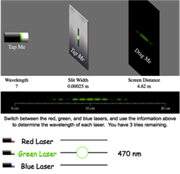 Young's Experiment Interactive Physics Interactive
Young's Experiment Interactive Physics Interactive
This interactive from The Physics Classroom simulates a Young's Experiment set-up using laser light shining upon a double slit. Students make measurements of the slit separation distance, the slit-to-screen distance, and the band separation distance on the screen. The information is then used in Young's equation to determine the wavelength of the laser light. Once students have determined the values of wavelength for the three lasers (red, green, and blue), they can check their answers. Feedback is immediate. Three opportunities are provided to get the correct answers for wavelength.
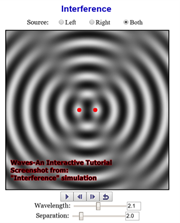 Waves: An Interactive Tutorial
Waves: An Interactive Tutorial
Here you’ll find an exemplary free collection of interactive simulations in eBook format to explore the physics of waves, authored by physics professor Kyle Forinash and Physlet Physics author Wolfgang Christian. Each of the 33 simulations is ready to run on mobile devices and includes question sets to gauge student understanding. You can start with basic properties, or move directly into more complex concepts such as interference, group velocity, boundary collisions, constructive/destructive interference, diffraction, dispersion of light, and polarization. Can be easily shared or embedded.
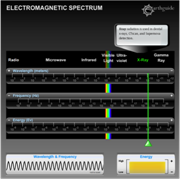 Earthguide: Electromagnetic Spectrum Interactive
Earthguide: Electromagnetic Spectrum Interactive
Students will have fun exploring the EM Spectrum with this interactive tool developed at the Scripps Institution of Oceanography. Move the slider to investigate the differences among the seven types of electromagnetic radiation: radio, microwave, infrared, visible light, ultraviolet, X-ray, and gamma. Values for wavelength in meters, frequency in Hertz, and energy in energy volts are given, along with conceptual representations of energy levels and frequency patterns. Teachers: This resource could be a good choice for students with disabilities or who are struggling with the content.
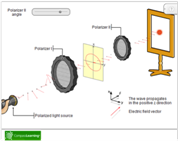 Compass Learning: Polarizer
Compass Learning: Polarizer
This simple simulation lets students shoot a beam of light through two polarizers. Starting with an elliptically polarized beam, the polarizer transforms this incident beam into a linearly polarized one. Use the slider to change the orientation of the second polarizer. You can also rollover the electric field vectors to reveal the polarization plane. Good starting point for students to gain conceptual understanding.
Video and Animations
 Veritasium: The Original Double Slit Experiment
Veritasium: The Original Double Slit Experiment
To produce this 7-minute video, Veritasium host Derek Muller traveled to the vault underneath the Royal Society in London to see Thomas Young’s original notes. Why? So he could recreate the historic double-slit experiment accurately. Dr. Muller used a mini-refrigerator box, a commercial double-slit slide (they’re called “diaphragms” and are readily available at science supply stores for < $20), and an eyepiece for viewing the pattern in the dark box. He took the homemade apparatus out in bright sunlight and asked volunteers for predictions of what they would see. Almost all said, “Two bright lines at the bottom of the box. Surprise, surprise! Teachers: We think this is a great way to help students see the phenomenon of double slit interference and understand the significance of Young’s experiment.
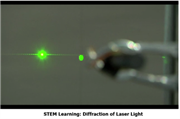 STEM Learning Centre: Diffraction of Laser Light
STEM Learning Centre: Diffraction of Laser Light
“Light waves – we use the phrase all the time, yet rarely do we ever see any phenomenon that really exposes the wave nature of light.” This superb resource from the UK’s Institute of Physics features two videos narrated by research scientist Michael de Podesta – one video for teachers that fully explains the phenomenon and a second aimed at students. Dr. de Podesta demonstrates how a laser and a thin wire can be used to show diffraction and interference of light. The video quality is good enough to use in lieu of a classroom demo. Bonus: Don’t miss the Teachers’ Notes from the IOP on teaching about diffraction using laser pointers.
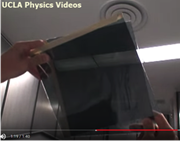 UCLA Physics Videos: Polarization of Light
UCLA Physics Videos: Polarization of Light
Here’s another gem from the UCLA Physics Demo collection featuring physics teacher James Lincoln explaining linear polarization of light in a 2-minute video. Lincoln does a macro-scale demonstration to show how we know that light is a transverse wave. He then uses polarized light filters to show how the concept shown in the demo can be extended to light phenomena. Note: You could easily set up this demo in your own class.
 Tout Est Quantique: Wave Particle Duality
Tout Est Quantique: Wave Particle Duality
Every quantum object is both a particle and a wave. This concept is a key foundation for learning modern physics. We know that quantum objects have wave-like behavior, but try to locate it with measuring instruments and the object is reduced to one spot. “Tout Est Quantique” is French for “All Is Quantum”. Created by the research group at University of Paris-Sud Solid State Physics Laboratory, this website hosts the wonderful collection of videos produced by Physics Reimagined -- some of the world’s finest animations on quantum phenomena. This animation depicts a double-slit set-up with a light source, a plate pierced by two parallel slits, and a screen where light passing through the slits is observed. It shows three objects being fired through the slits: single particles, waves, and a “quantum object”.
 Tout Est Quantique: Polarizing Microscope
Tout Est Quantique: Polarizing Microscope
Want a challenge for your AP students? This animation from Physics Reimagined shows what happens when a birefringent sample is positioned along a light beam with two perpendicular filters. Normally, no wave could pass through such a set-up. But birefringent materials produce a “double refraction” phenomenon that splits the light into two rays!
Labs and Investigations
- The Physics Classroom, The Laboratory, Ripple Tank Lab
Students analyze a two point source interference pattern and develop a path difference equation for nodes and for anti-nodes.
- The Physics Classroom, The Laboratory, Two-Point Source Analysis
Students analyze a two-point source interference pattern in order to obtain wavelength two different ways - using a path difference equation and using Young's equation. They compare results and speculate on reasons for the differences.
- The Physics Classroom, The Laboratory, Two-Point Source Analysis
Students analyze a two-point source interference pattern in order to obtain wavelength two different ways - using a path difference equation and using Young's equation. They compare results and speculate on reasons for the differences.
- The Physics Classroom, The Laboratory, Young's Experiment Lab
Students perform a modern-day Young's Experiment using laser light, a double-slit, and a screen. They make measurements and calculate the wavelength of the laser light.
- The Physics Classroom, The Laboratory, Getting It Right with Light
Students make a collection of observations using a pair of Polaroid filters and develop a model to explain how they work.
Link: http://www.physicsclassroom.com/lab/light/Llabs.html
Hands-On Investigation
 Teaching Advanced Physics (TAP): Polarisation
Teaching Advanced Physics (TAP): Polarisation
This lesson module, developed by the UK’s Institute of Physics, promotes active learning about concepts of polarization and how it is applied in wave technology. It’s as close to turn-key as you can find, with opening discussion tips, high-quality diagrams for full-class projection, complete procedurals for setting up two class demonstrations, a lab experiment to investigate radio and TV signals, and a robust problem set with answer key. Just for fun, the extension activity explores how “polarimeters” are used in the candy industry to measure sugar concentration. No, we didn’t misspell the title here. In the UK, the word is spelled “polarization” with an “s”.
Historical Context
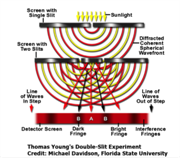 Microscopy U: Principles of Interference
Microscopy U: Principles of Interference
This in-depth resource explores EM wave interference in the context of historical discovery. It takes the student on a journey that begins with Thomas Young’s classic experiment, fully explaining Young’s set-up and the historical repercussions of his findings. Although Young’s conclusions were ridiculed at the time, his Double Slit Experiment explained the puzzling phenomenon observed by Isaac Newton in his well-known work with convex lenses (Newton’s Rings). Young paved the way for understanding the principles of light interference, leading to many important technological innovations.
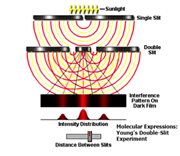 Microscopy Resource Center: Light – Particle or a Wave
Microscopy Resource Center: Light – Particle or a Wave
This resource is part of a collection co-authored by renowned microscopist Michael Davidson, a researcher at Florida State University. It takes the learner through a brief history of the debate surrounding the dual nature of light – particle, wave, or both? The contributions of Huygens, Newton, Young, Maxwell, Lenard, and Einstein are explored through narrative and five interactive Java animations, which run well in Firefox. Teachers: Even if you normally avoid Java-based resources, we suggest you consider this as your exception. Sadly, Michael Davidson died in 2015 after a short illness, which is why his materials have not been rewritten to HTML.
Classroom Presentaton Materials
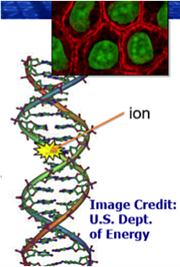 U.S. Department of Energy: Ionizing Radiation
U.S. Department of Energy: Ionizing Radiation
Here you’ll find a great warm-up activity to introduce students to the dangers of ionizing radiation. This annotated Power Point presentation developed by the DOE takes a deep look at the energy spectrum of radiation, from low-frequency non-ionizing radiation to the higher-frequency ionizing radiation that can damage living cells. The presentation explains how unstable isotopes emit particles in the radioactive decay process, discusses half-life, and diagrams different radiation particles to show how they penetrate tissue. Students will use a dose calculator to determine their “Personal Radiation Dose” and watch a 10-minute video of a scientist demonstrating radiation effects. Includes a short assessment.
Minds On Physics Internet Modules:
The Minds On Physics Internet Modules are a collection of interactive questioning modules that target a student’s conceptual understanding. Each question is accompanied by detailed help that addresses the various components of the question.
- Light and Color Module, Ass’t LC1 - Electromagnetic and Visible Radiation
- Light and Color Module, Ass’t LC2 - Polarization
Concept Building Exercises:
- The Curriculum Corner, Light and Color, Light Waves and Matter
- The Curriculum Corner, Light and Color, Polarization
Problem-Solving Exercises:
- The Calculator Pad, Light and Color, Problems #10 - #25
Link: http://www.physicsclassroom.com/calcpad/light/problems
Science Reasoning Activities:
- Light and Color: Cell Phone Radiation and Cancer
Link: http://www.physicsclassroom.com/reasoning/light
Standards:
A. Next Generation Science Standards (NGSS)
Performance Expectation: High School Physical Science - Waves
- HS-PS4-3: Evaluate the claims, evidence, and reasoning behind the idea that electromagnetic radiation can be described either by a wave model or a particle model, and that for some situations one model is more useful than the other.
Disciplinary Core Ideas: Physical Science - Waves
- Wave Properties: HS-PS4.A.iii: Waves can add or cancel one another as they cross, depending on their relative phase (i.e., relative position of peaks and troughs of the waves), but they emerge unaffected by each other.
- Electromagnetic Radiation: HS-PS4.B.i: Electromagnetic radiation (e.g., radio, microwaves, light) can be modeled as a wave of changing electric and magnetic fields or as particles called photons. The wave model is useful for explaining many features of electromagnetic radiation, and the particle model explains other features.
- Electromagnetic Radiation: HS-PS4.B.ii: Shorter wavelength electromagnetic radiation (ultraviolet, X-rays, gamma rays) can ionize atoms and cause damage to living cells.
Crosscutting Concepts
Patterns
- Grades 9-12: Different patterns may be observed at each of the scales at which a system is studied and can provide evidence for causality in explanations of phenomena.
Science and Engineering Practices
Practice #1: Analyzing and Interpreting Data
- Grades 9-12: Analyze data using tools, technologies, and/or models (e.g., computational, mathematical) in order to make valid and reliable scientific claims.
Practice #3: Constructing Explanations
- Grades 9-12: Construct an explanation based on valid and reliable evidence obtained from a variety of sources (including students’ own investigations, models, theories, simulations) and the assumption that theories and laws that describe the natural world operate today as they did in the past and will continue to do so in the future.
Practice #4: Developing and Using Models
- Grades 9-12: Use a model to provide mechanistic accounts of phenomena.
- Grades 9-12: Develop and use a model based on evidence to illustrate the relationships between systems or between components of a system.
Practice #8: Using Mathematics and Computational Thinking
- Grades 9-12: Use mathematical representations of phenomena to describe explanations.
- Grades 9-12: Use mathematical models and/or computer simulations to predict the effects of a design solution on systems and/or interactions between systems.